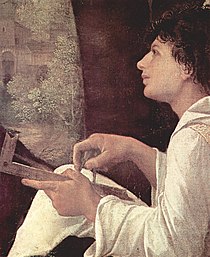The Three Philosophers
| The Three Philosophers | |
|---|---|
 |
|
| Artist | Giorgione |
| Year | c. 1505–1509 |
| Medium | Oil on canvas |
| Dimensions | 123 cm × 144 cm (48 in × 57 in) |
| Location | Kunsthistorisches Museum, Vienna |
 |
|
| Audio | |
|---|---|
|
|
|
| Video | |
|
|
The Three Philosophers is an oil painting on canvas attributed to the Italian High Renaissance artist Giorgione. It shows three philosophers - one young, one middle-aged, and one old. The work was commissioned by the Venetian noble Taddeo Contarini, a Venetian merchant with an interest in the occult and alchemy. The Three Philosophers was finished one year before the painter died. One of Giorgione’s last paintings, it is now displayed at the Kunsthistorisches Museum in Vienna. The painting was finished by Sebastiano del Piombo.
The Three Philosophers was finished around 1509, and the current name of the work derives from a writing of Marcantonio Michiel, (1484–1552) who saw it just some years after in a Venetian villa. The three figures portrayed are allegorical: an old bearded man, possibly a Greek philosopher; an Arab philosopher; and a sitting young man, enclosed within a natural landscape. In the background is a village with some mountains, the latter marked by a blue area whose meaning is unknown. The young man is observing a cave on the left of the scene, and apparently measuring it with some instruments. Since the end of the 19th century scholars and critics rejected on various grounds the earlier view that it is a representation of the three Magi gathered before Jesus' grotto.
Various interpretations about Giorgione's picture have been proposed. The Three Philosophers, the old man, the Arab figure and the young man, could be a depiction of transmission of knowledge, the Transmission of the Classics from the ancient Greeks philosophy through the Arab translations, that became actual again around the Italian Renaissance. The old man is representing a Greek philosopher, such as Plato or Aristotle, whose writings have been copied and transmitted through the Arab philosophers to the Italian Renaissance. The Arab philosopher is possibly representing the polyhistor Avicenna or Averroes, both Arab philosophers and Arab scientists from the Islamic Golden Age.
...
Wikipedia
